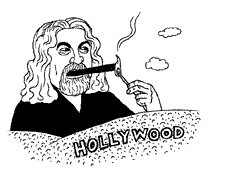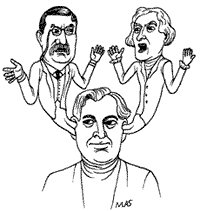
Movies
An Alan Smithee Film: Burn Hollywood Burn (Hollywood Pictures). Reviewers pan this mock-documentary about a director named Alan Smithee who destroys the negatives for his forthcoming film. "[A] stunningly bad, sophomorically vulgar parody" (Jack Mathews, Newsday). (Intended joke: Alan Smithee is the pseudonym used when a director removes his name from a film's credits. Unintended joke: Burn Hollywood Burn's director took his name off the credits.) Problems are said to include a glut of heavy-handed in-jokes; a spiteful tone; and disjointed editing, done by the film's despised screenwriter, Joe Eszterhas (Showgirls). (The film is plugged here.)
Krippendorf's Tribe (Touchstone Pictures). Critics disagree on the merits of this sendup of academia starring Richard Dreyfuss. Some accuse the film--about an anthropologist who fakes discovering an indigenous tribe--of purveying racial stereotypes. Its laughs are as crude as the chuckles of "little boys sniggering over National Geographic" (Susan Wloszczyna, USA Today). Others say its digs at ivory-tower credulousness and Dreyfuss' turn as a neurotic professor make it "too funny to ignore" (David Denby, New York). (The trailer is available here.)
Lolita. Tired of waiting for the film to find an American distributor, critics weigh in on Fatal Attraction director Adrian Lyne's controversial adaptation of Nabokov's 1955 novel. Michael Wood, in the New York Review of Books, says the film, which stars Jeremy Irons and Melanie Griffith, "is downright demure; deeply, almost debilitatingly loyal to Nabokov's novel." The New Yorker's Anthony Lane calls it "a slight, tender movie--not, I think, worth fighting a battle over."
Music
Ray of Light, by Madonna (Warner Bros.). The material girl goes spiritual with her first pop album in four years. It works. Critics are charmed by Madonna's newfound passion for Kabbalah and impressed by her frank treatment of her own careerism. "A flawless, grown-up" album, says the Times of London's Alan Jackson. Praise also goes to her integration of techno beats and computer effects. The 39-year-old diva thus recovers from an early-'90s "creative nadir"--Erotica and Sex--that "reeked of heat-seeking desperation" (David Browne, Entertainment Weekly). (Audio clips are available here.)

Book
The Smithsonian Institution, by Gore Vidal (Random House). Reviews for Vidal's 23rd novel range from poor to lukewarm. The story is viewed as a paltry excuse for Vidal to lash out yet again at American imperialism (set in 1939, it is the tale of a 13-year-old prep-schooler in the Smithsonian after-hours, when the exhibits come to life). The forays into science fiction are said to have "the unfortunate effect of liberating all [Vidal's] worst artistic impulses" (James Bowman, the Wall Street Journal). Vidal does win praise for caustic portrayals of dead presidents--with all the "freaks and foibles"--of the sort he has brought to his other historical fiction (Christopher Benfey, the New York Times Book Review).
Theater
Art (Royale Theatre, New York City). As did their London and Paris counterparts, most New York critics rave over French playwright Yasmina Reza's satire about modern art. Her comedy about an argument over the merits of an all-white painting is "like a marriage of Molière and Woody Allen" (Jack Kroll, Newsweek). Key points: the accessibility of the aesthetic debate; the hilarious banter; and the Seinfeld-like characters, especially that of an egomaniac (played by Alan Alda). But some critics dismiss the controversy over white paintings as slight and old-hat: "theatrical brain candy but from a gourmet shop" (Linda Winer, Newsday).
Art
"Chuck Close" (Museum of Modern Art, New York City). The 57-year-old portraitist wins acclaim for bucking trendy postwar art movements. His billboard-size faces are said to hearken back to Rembrandt and classical court artists. The critical favorites are Close's later, quasipointillist portraits, which he completed after a blood-vessel injury paralyzed him. The power of his work is attributed to its scale and his meticulous method. "His pictures ... are like magic tricks," says the New York Times' Michael Kimmelman. (MoMA trumpets the show here.)
Update
In the New York Times Book Review, Katha Pollitt calls for a truce in the battle between partisans of Sylvia Plath and Ted Hughes: "What if, as in many bad marriages, both partners were driven to the extremes of their personalities, ... what if his poems and her poems each represent the limited, self-justifying perspective of a terribly injured and injuring spouse?"
Recent "Summary Judgment" columns
Television--The American Experience: Reagan (PBS);
Television--The Wedding (ABC);
Television--The Closer (CBS);
Movie--Palmetto;
Book--Cloudsplitter, by Russell Banks;
Art--"Fernand Léger" (Museum of Modern Art);
Theater--Freak.
Movie--Sphere;
Movie--Mrs. Dalloway;
Movie--The Wedding Singer;
Book--The Street Lawyer, by John Grisham;
Book--Riven Rock, by T. Coraghessan Boyle;
Television--18th Winter Olympics (CBS);
Theater--The Vagina Monologues.
Movie--Nil by Mouth;
Movie--Blues Brothers 2000;
Oscar Nominations, early reviews;
Theater--Shopping and Fucking;
Book--Jack Maggs: A Novel, by Peter Carey;
Book--Black and Blue, by Anna Quindlen;
Music--Yield, by Pearl Jam;
Art--"China: 5,000 Years" (Guggenheim).
Theater--The Capeman;
Television--Clinton-Sex-Scandal Coverage;
Television--Dawson's Creek (The WB);
Movie--Great Expectations;
Movie--Desperate Measures;
Book--Cuba Libre, by Elmore Leonard;
Book--The House Gun, by Nadine Gordimer.
--Franklin Foer
